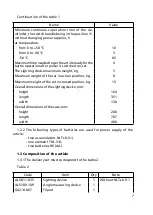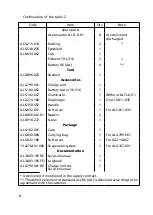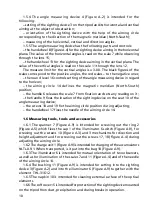
9
1.4 Design and operation
.4. The main components of the article are the sighting device 3 (Figure A.2),
the illuminator 2, the handle for fastening the illuminator on the sighting
device for carrying the sighting device, the tripod 5 on which angle measuring
device 4 with the sighting device are fastened.
.4.2 The operation principle of the sighting device is based on the electro-
optical intensification of the image brightness of the objects (targets) at night
to such degree which is sufficient for eye observation.
.4.3 The sighting device operation at night is provided by the IIT A2 (Figure A.) of
heightened sensibility with micro channel intensification and automatic adjustment
of the screen brightness. The image of objects with little brightness is projected to
the photocathode of the IIT A2 by the objective , the IIT is located in the focal plane
of the objective .
The object image with intensified brightness on the screen of the IIT A2 is
transferred to the plane of the reticle 3 by the erector 2 and is viewed together
with the reticle 3 through the ocular 4.
.4.4 The figure A.6 shows the field of view of the sighting device (each
angle dimension between the lines presents one-thousandths part of the real
distance).
.4.5 When the switch SA (Figure A.) is switched on, 2.0 – 3.6 V voltage is
given to the IIT from the power supply G and G2.
1.5 Design and operation of the components of the article
.5. The sighting device3 (Figure A.2) consists of the following parts:
– the objective (Figure A.3) which is intended for projecting image of the
observed aim of little brightness to the photocathode of the IIT A2 (Figure A.);
– the ocular 8 (Figure A.3) which is intended for observation of the object.
.5.2 The sighting device has the following controls:
– the handle 2 which is intended for switching on the sighting device and
for switching on the reticle illumination;
– the diopter ocular setting ring 5 which allows to adjust the ocular according
to the diopters of the observer;
– the handwheel 2 which is intended for obtaining sharp image of the
observed object at the corresponding distance and for the compensation of
defocusing when the temperature changes from +50 to –50 °C.
.5.3 The tripod 5 (Figure A.2) is intended for fixing the sighting device 3 with
the angle measuring device 4 on the ground while working with the sighting
device in lying or sitting position.
Adjusting of the tripod height is carried out with the help of the telescopic
supports (Figure A.4), whose position is fixed with the help of the nuts 2.
The strap 3 is intended for tightening of the legs 4 during transportation.
When stored and transported in the case, the tripod is put into the soft cover 7
(Figure A.9).
Summary of Contents for 1PN91-2
Page 1: ...ARTICLE 1PN91 2 Service manual AL3 803 105 RE...
Page 2: ......
Page 37: ...37 2 1 3 1 cap 2 ring 3 cap Figure A 5 The illuminator...
Page 38: ...38 Figure A 6 The field of view of the sighting device...
Page 39: ...39 Figure A 7 The Landolt ring for checking illumination...
Page 40: ...40 Figure A 8 The chart for illumination defining Illumination lux distance m...
Page 43: ...43 1 91 2...






































